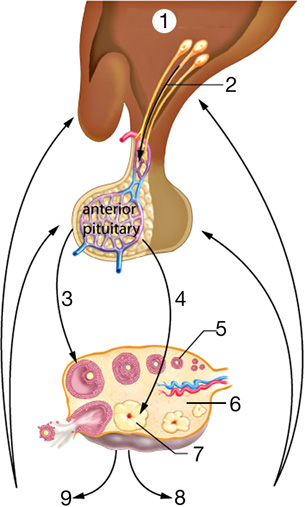Module 3
1. Module 3
1.33. Page 2
Module 3—The Male and Female Reproductive Systems
 Explore
Explore
To understand the hormonal control of the female reproductive system, it is recommended to first do the reading and then watch the video segments. It is recommended that you make your own notes, particularly in the form of a flow chart or concept map as well as a feedback loop illustrating the menstrual cycle. The feedback loop is an essential tool in understanding the events of the menstrual cycle. Store your work in your course folder for later review.
 Read
Read
To understand the regulation of the menstrual cycle, read pages 495 to 499 in the textbook, starting with the section titled “Sex Hormones and the Female Reproductive System” through to the “Summary.”
 Watch and Listen
Watch and Listen
It is hard to separate female sex hormones from the menstrual cycle, so for the best understanding of the menstrual cycle, it is recommended that you view the entire video “Hormonal Controls and the Menstrual Cycle: The Renewal of Life” video. You have already seen this video in Lesson 7, but reviewing this material will help you integrate the information. You may be required to enter a username and password in order to access the video. Contact your teacher for this information.
In Unit A you learned how to draw feedback loops. You may find that preparing a feedback loop of the events of the menstrual cycle helps you understand the events in the correct sequence. Check your work with your teacher.
 Self-Check
Self-Check
The reading and video examine how the menstrual cycle is controlled by hormones. Test your understanding of hormonal control of the ovarian cycle by correctly labelling the following images.
SC 1. Provide labels for the following diagram, which shows the hormonal control of the ovarian cycle. Outline the steps involved in this flow chart.

Inquiry into Biology (Whitby, ON: McGraw-Hill Ryerson, 2007), 496, fig. 14.15 Reproduced by permission.
SC 2: Provide labels for the following diagram, which shows the the ovarian cycle. Outline the steps involved in this flow chart.

Inquiry into Biology (Whitby, ON: McGraw-Hill Ryerson, 2007), 496, fig. 14.14 Reproduced by permission.
 Self-Check Answers
Self-Check Answers
SC 1. Hormonal Control of the Ovarian Cycle
- hypothalamus
- GnRH
- LH
- FSH
- follicle
- ovary
- corpus luteum
- progesterone
- estrogen
The hypothalamus produces gonadotropin releasing hormone (GnRH), which stimulates the anterior pituitary to produce follicle-stimulating hormone (FSH) and luteinizing hormone (LH). FSH stimulates the follicle to produce estrogen. LH stimulates the corpus luteum to produce progesterone.
SC 2. The Ovarian Cycle
- ovary
- oviduct
- uterus
- vagina
- developing follicles
- mature follicle
- ovum
- ovum released
- corpus luteum
- degenerating corpus luteum
- corpus albicans
- blood vessels
- immature follicles
A follicle matures by growing layers of follicular cells and a central fluid-filled vesicle. The vesicle contains the maturing ovum. At ovulation, the follicle ruptures and the ovum is released into the oviduct. The follicle develops into a corpus luteum. If pregnancy does not occur, the corpus luteum starts to degenerate after about 10 days. Note that the follicle does not migrate around the ovary, as shown here for clarity, but goes through all the stages in one place.
 Module 3: Lesson 8 Assignment
Module 3: Lesson 8 Assignment
Retrieve the copy of the Module 3: Lesson 3 Assignment that you saved to your computer earlier in this lesson. Complete the assignment. Save your completed assignment in your course folder. You will receive instructions later in this lesson about when to submit your assignment to your teacher.
 Discuss
Discuss
In the course discussion area, discuss one, a few, or all of the following questions.
D 1. What are medication-free ways of helping to have a pain free and/or regular menstrual cycle?
D 2. Why do females who live together often have menstrual cycles that happen at the same time?